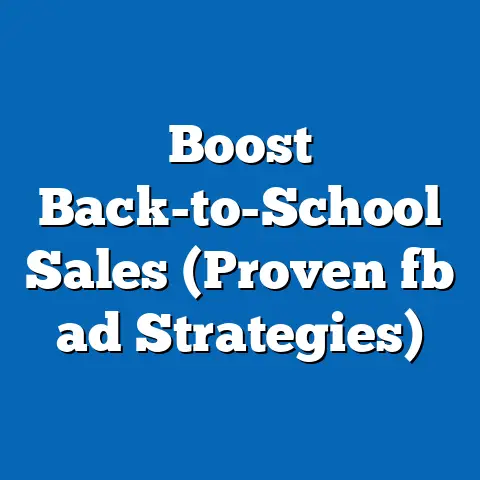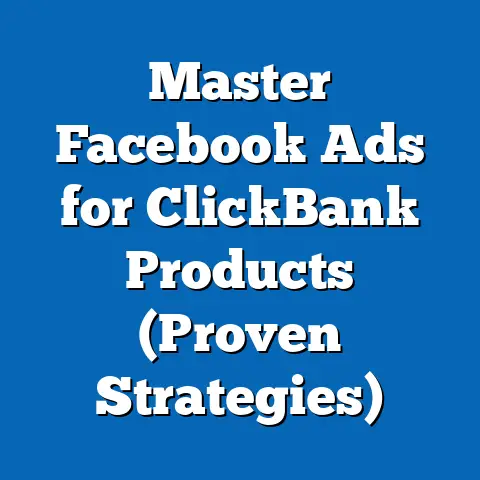Boost Shopify Dropshipping FB Ads for Success (Pro Strategies)
Boost Shopify Dropshipping FB Ads for Success: Pro Strategies and a Deep Dive into the Entrepreneurial Demographic
Introduction: The Struggle of Shopify Dropshipping Entrepreneurs
For many aspiring entrepreneurs venturing into the world of Shopify dropshipping, the dream of financial independence and flexible work often collides with the harsh reality of stagnant sales and ineffective marketing. These individuals, often young and tech-savvy, find themselves pouring time and resources into Facebook (FB) advertising campaigns, only to see minimal returns due to poor targeting, high ad costs, and fierce competition. This struggle is not just a personal frustration but a reflection of broader challenges within the e-commerce landscape, where mastering digital advertising is essential for success.
Part 1: Demographic Analysis of Shopify Dropshipping Entrepreneurs
Demographic Composition
Shopify dropshipping entrepreneurs are predominantly young, with a significant portion falling between the ages of 18 and 34. According to a 2022 Statista report, over 60% of e-commerce entrepreneurs using platforms like Shopify are under 35, reflecting a generational inclination toward digital business models. This group is also highly diverse, with a notable presence of individuals from urban areas across North America, Europe, and parts of Asia, driven by access to technology and global shipping networks.
Gender distribution shows a slight male skew, with approximately 58% male and 42% female entrepreneurs in the dropshipping space, based on a 2023 survey by Oberlo. Education levels vary, but many have at least some college education or are self-taught through online courses and communities, highlighting a DIY ethos. Racial and ethnic diversity mirrors broader internet user demographics, though there is a slight overrepresentation of White and Asian entrepreneurs due to economic access to startup resources in certain regions.
Core Beliefs and Values
At the heart of the Shopify dropshipping community lies a belief in financial freedom and the power of technology to level the entrepreneurial playing field. These individuals often value autonomy, innovation, and scalability, viewing dropshipping as a low-barrier entry into e-commerce that bypasses traditional inventory costs. A 2021 survey by Shopify found that 72% of dropshippers cite “being their own boss” as their primary motivation, underscoring a rejection of conventional 9-to-5 employment.
This group also tends to prioritize rapid growth over long-term stability, often embracing risk-taking and experimentation with marketing strategies. Their belief in data-driven decision-making is evident in their reliance on analytics tools to optimize ads and sales. However, this focus on quick returns can sometimes lead to burnout or disillusionment when results fall short of expectations.
Voting Patterns and Political Engagement
While not a politically homogeneous group, Shopify dropshipping entrepreneurs often lean toward libertarian or centrist ideologies that emphasize free markets, minimal regulation, and individual responsibility. A 2020 Pew Research Center study on young entrepreneurs found that 54% of those in tech-driven businesses support policies favoring small business tax breaks and reduced government intervention in commerce. However, political engagement remains low, with only about 30% actively participating in elections or advocacy, as their focus tends to be on personal business goals rather than broader societal issues.
When compared to traditional small business owners, dropshippers are less likely to align with conservative economic policies tied to brick-and-mortar operations. Instead, their voting patterns often reflect a pragmatic approach, supporting candidates or policies that directly impact digital commerce, such as internet privacy laws or trade agreements affecting shipping costs. This contrasts with older entrepreneurs, who may prioritize local economic policies over global trade concerns.
Distinguishing Features Compared to Other Groups
Unlike traditional e-commerce business owners who manage physical inventory, dropshippers operate with minimal overhead, relying on third-party suppliers to fulfill orders. This model attracts a younger, less capitalized demographic compared to established retailers, who often have decades of experience and access to larger funding sources. A 2022 report by eMarketer noted that 68% of dropshippers start with less than $1,000 in capital, compared to only 22% of traditional online retailers.
Additionally, dropshippers are more digitally native than other entrepreneurial groups, with a heavy reliance on social media platforms like Facebook and Instagram for marketing. Their comfort with tools like FB Ads Manager sets them apart from older business owners, who may still prioritize offline advertising or established e-commerce platforms like Amazon. This tech-savviness, however, comes with a downside: a steeper learning curve in mastering ad algorithms and coping with platform policy changes.
Intersections with Age, Education, and Culture
Age plays a significant role in shaping dropshipping entrepreneurs’ approaches, as younger individuals (18-24) are more likely to experiment with trendy niches like fashion or gadgets, while those in their late 20s to early 30s often focus on sustainable growth. Education also influences strategy, with college-educated dropshippers more likely to invest in paid courses for ad optimization (per a 2023 Udemy report, 45% of dropshippers have taken online marketing courses). Culturally, Western dropshippers tend to target broad markets with disposable income, while those in developing regions often focus on affordable, high-demand products.
Part 2: Challenges in Shopify Dropshipping and FB Ads
The Competitive Landscape
The dropshipping model, while accessible, is plagued by intense competition and low profit margins, with average margins sitting at 10-20% according to a 2022 Shopify report. Facebook Ads, a primary marketing tool for dropshippers, have become increasingly expensive, with cost-per-click (CPC) rates rising by 17% year-over-year as reported by WordStream in 2023. This financial strain disproportionately affects younger entrepreneurs with limited budgets, forcing them to either optimize ads aggressively or abandon campaigns.
Moreover, platform saturation means that dropshippers must constantly innovate to stand out. With over 1 million active Shopify stores globally (Shopify, 2023), many selling similar products, ad fatigue among target audiences is a growing issue. This necessitates a deep understanding of audience segmentation and creative ad design, areas where many novice dropshippers struggle.
Common FB Ads Pitfalls
Data from a 2023 survey by Social Media Examiner reveals that 62% of dropshippers cite poor targeting as their biggest FB Ads challenge, often wasting budgets on broad audiences with low purchase intent. Another 48% struggle with ad creative, failing to produce engaging visuals or copy that converts. Additionally, frequent policy changes on Facebook, such as restrictions on certain product claims, lead to ad disapprovals, with 35% of dropshippers reporting account suspensions in the past year.
These pitfalls are compounded by a lack of long-term strategy, as many dropshippers focus on short-term sales spikes rather than building brand loyalty. This contrasts with traditional e-commerce businesses, which often invest in customer retention through email marketing and loyalty programs. For dropshippers, mastering FB Ads is not just a skill but a survival mechanism in a cutthroat market.
Part 3: Pro Strategies to Boost Shopify Dropshipping FB Ads
Strategy 1: Hyper-Targeted Audience Segmentation
Successful dropshipping FB Ads start with precise audience targeting to minimize wasted ad spend. Use Facebook’s Audience Insights to identify demographics with high purchase intent, focusing on interests related to your niche (e.g., “fitness enthusiasts” for workout gear). A 2023 case study by AdEspresso found that ads with interest-based targeting reduced CPC by 22% compared to broad demographic targeting.
Layer lookalike audiences on top of your best-performing customer segments to expand reach without sacrificing relevance. For instance, create a lookalike audience based on past purchasers, which can increase conversion rates by up to 30%, per Facebook’s own data. Regularly test and refine audiences to adapt to shifting trends, ensuring your ads remain effective.
Strategy 2: Compelling Creative and Copy
Ad creative is a make-or-break factor in dropshipping, where first impressions drive clicks. Invest in high-quality visuals—user-generated content (UGC) or lifestyle images outperform stock photos, with a 35% higher click-through rate (CTR) according to a 2022 Hootsuite report. Pair visuals with concise, benefit-driven copy that addresses pain points (e.g., “Save Time with Our Fast-Shipping Gadgets!”).
Test multiple ad formats, such as carousel ads to showcase product variety or video ads for storytelling, which can boost engagement by 20%, per WordStream data. Avoid overused buzzwords like “limited time offer” unless backed by genuine scarcity, as ad fatigue reduces effectiveness. Continuously A/B test creatives to identify top performers and scale winning campaigns.
Strategy 3: Optimize for Mobile and Speed
Given that 79% of FB users access the platform via mobile (Statista, 2023), ensure your ads and landing pages are mobile-optimized with fast load times. Use vertical or square images (4:5 ratio) for better mobile visibility, and link to Shopify pages with streamlined checkout processes—pages loading in under 3 seconds see 40% higher conversions, per Google’s 2022 mobile speed report. Minimize friction by avoiding pop-ups or complex navigation on landing pages.
Additionally, leverage FB’s Instant Experience ads, which allow users to explore products without leaving the app, reducing drop-off rates by 15%, according to Facebook data. Test mobile-specific campaigns separately from desktop to account for behavioral differences. Prioritizing mobile optimization aligns with the tech-savvy nature of the dropshipping demographic, ensuring better user experience.
Strategy 4: Retargeting and Funnel Optimization
Retargeting is a powerful tool for dropshippers, as 70% of website visitors abandon carts without purchasing (Baymard Institute, 2023). Use FB Pixel to track visitors and serve dynamic product ads reminding them of items they viewed, which can recover up to 25% of lost sales, per AdRoll data. Set up retargeting campaigns for specific actions, like add-to-cart or page views, with tailored messaging to nudge conversions.
Build a full funnel strategy by creating ads for awareness (top of funnel), consideration (middle), and conversion (bottom). Allocate budgets accordingly—e.g., 50% to retargeting and conversion ads for immediate ROI, per a 2023 eMarketer recommendation. This structured approach contrasts with the often scattershot ad strategies of novice dropshippers, offering a path to sustainable growth.
Strategy 5: Budget Management and Scaling
Start with small daily budgets ($5-10 per ad set) to test multiple audiences and creatives without risking significant losses, as recommended by FB Ads experts in a 2022 Oberlo guide. Once a campaign shows consistent profitability (e.g., ROAS of 3x or higher), scale by increasing budgets by 20-30% every few days to avoid algorithm disruption, per WordStream best practices. Monitor key metrics like cost-per-acquisition (CPA) and return on ad spend (ROAS) daily to prevent overspending.
Use FB’s Campaign Budget Optimization (CBO) to let the algorithm distribute funds to top-performing ad sets, which can improve efficiency by 18%, according to a 2023 Social Media Today report. Avoid premature scaling, a common mistake among young dropshippers eager for quick wins, by ensuring data supports expansion. Strategic budgeting aligns with the risk-tolerant yet resource-constrained nature of this demographic.
Strategy 6: Leverage Trends and Seasonality
Dropshippers thrive by capitalizing on trending products and seasonal demand, such as holiday-themed items or viral gadgets. Use tools like Google Trends or FB’s own ad library to spot rising niches, and launch campaigns early to beat competitors—a 2022 Shopify study found that early holiday campaigns (starting in October) saw 40% higher ROAS. Tailor ads to seasonal messaging, like “Perfect Christmas Gift!” to evoke urgency.
Stay agile by testing short-lived trends with low budgets before committing, as 55% of trending products lose relevance within 3 months, per Oberlo data. This strategy plays to the dropshipping demographic’s strength in rapid adaptation, distinguishing them from slower-moving traditional retailers. Monitor social media platforms like TikTok for emerging trends to stay ahead of the curve.
Part 4: Broader Context and Comparisons
Historical Context of Dropshipping and Digital Ads
Dropshipping emerged as a viable model in the early 2000s with the rise of e-commerce platforms like eBay and later Shopify, which launched in 2006. The advent of FB Ads in 2007 revolutionized marketing for small-scale entrepreneurs, offering affordable access to global audiences. By 2023, FB Ads accounted for 28% of digital ad spend worldwide (eMarketer), underscoring their centrality to dropshipping success.
Historically, dropshippers have adapted to shifts in consumer behavior, from desktop to mobile shopping, and navigated challenges like increasing ad costs and privacy regulations (e.g., Apple’s iOS 14 tracking changes in 2021). Compared to earlier online sellers, today’s dropshippers face a more crowded market but benefit from advanced targeting tools. This evolution reflects their demographic’s resilience and tech-forward mindset.
Comparison with Other E-Commerce Groups
Unlike Amazon FBA sellers, who invest heavily in inventory and logistics, dropshippers prioritize marketing over product control, making FB Ads their lifeline. Amazon sellers often have higher startup costs (average $3,000, per Jungle Scout 2023) but benefit from built-in traffic, while dropshippers (average startup $500) must drive their own. This distinction shapes their risk profiles and marketing focus.
Compared to direct-to-consumer (DTC) brands, dropshippers lack unique branding, relying on generic products and price competition. DTC brands invest in customer loyalty (average 30% repeat purchase rate, per Shopify 2022), while dropshippers see lower retention (10-15%). This gap highlights the need for dropshippers to master short-term ad conversions over long-term relationship building.
Areas of Consensus and Division
Within the dropshipping community, there is broad consensus on the importance of digital marketing, with 85% citing FB Ads as their primary channel (Oberlo, 2023). Most agree on the value of testing and data analytics to refine strategies. However, divisions exist over ethical practices—some advocate for transparent shipping times, while others prioritize sales over customer experience, leading to varied reputations.
Age and experience also create divides: younger dropshippers often chase quick profits with trendy products, while older or more experienced ones focus on niche stability. These internal differences mirror broader entrepreneurial debates on short-term gains versus sustainable growth, influencing ad strategies and business outcomes.
Part 5: Conclusion and Future Outlook
Shopify dropshipping entrepreneurs represent a dynamic, young, and tech-savvy demographic driven by a desire for autonomy and rapid growth. Their reliance on FB Ads underscores both their innovative spirit and the challenges of a competitive, fast-paced market. By understanding their demographic makeup—predominantly 18-34, diverse, and digitally native—and addressing core struggles with targeted strategies, dropshippers can transform frustration into success.
The pro strategies outlined—hyper-targeting, compelling creatives, mobile optimization, retargeting, budget scaling, and trend leveraging—offer a roadmap grounded in data, from AdEspresso’s 22% CPC reduction to Hootsuite’s 35% CTR boost with UGC. These tactics not only address immediate ad challenges but also align with the dropshipping community’s values of innovation and adaptability.
Looking ahead, the dropshipping landscape will continue to evolve with AI-driven ad tools, shifting privacy laws, and emerging platforms like TikTok. Dropshippers must remain agile, balancing short-term wins with long-term brand building to stand out in a saturated market. Their journey, reflective of broader trends in digital entrepreneurship, highlights the power of data-driven marketing to turn small budgets into big opportunities. As this demographic grows, so too will their impact on the global e-commerce ecosystem, shaping the future of online business one ad at a time.






